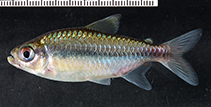| Family: |
Alestidae (African tetras) |
| Max. size: |
7 cm SL (male/unsexed) |
| Environment: |
pelagic; freshwater, |
| Distribution: |
Africa: Lower Guinea endemic, restricted to the Ogowe and Como River basins in Gabon (Ref. 80290). |
| Diagnosis: |
Anal spines: 0-0; Anal soft rays: 21-22. Diagnosis: 4.5 scales between lateral line and dorsal fin origin; 18-19 anal fin branched rays; flanks with dark lateral pigment band from opercular margin to caudal fin; humeral spot present (Ref. 80290).
Description: body moderately robust, greatest body depth 35-38% of SL and head length 30-33% of SL; mouth terminal to slightly superior, lower jaw prominent, its depth about 1.5x that of upper jaw; premaxilla with 2 teeth in outer row each bearing 3-5 cusps, 4 teeth in inner row each bearing 5-7 cusps; dentary with 4 teeth in outer row each bearing 5-7 cusps, a monocuspid inner dentary tooth present posterior to outer row teeth; lateral line canal complete, 25-27 tubes, ultimate canal-bearing scale separated from caudal fin rays by 2-3 non-canal-bearing scales; anal fin with 3 unbranched and 18-19 branched rays (Ref. 80290).
Coloration: flanks yellow-silver; broad distinct dark lateral band more or less continuous from opercular margin to posterior margin of median caudal fin rays; ovoid humeral spot often present in larger individuals; dorsum with diffuse pigmentation, somewhat darker than ventral half of body, tending toward multiple faint lateral bands in larger individuals; fins generally dusky to yellowish in life (Ref. 80290). |
| Biology: |
Affinities: most similar to Brachypetersius huloti from the Congo River basin, from which it differs in the extension of the lateral band onto the median caudal fin rays, presence of a humeral spot and fewer scales (4.5-5.5 vs 6.5) in transverse series between lateral line and dorsal fin origin (Ref. 80290). |
| IUCN Red List Status: |
Least Concern (LC); Date assessed: 16 February 2009 Ref. (130435)
|
| Threat to humans: |
harmless |
| Country info: |
|
Source and more info: www.fishbase.org. For personal, classroom, and other internal use only. Not for publication.

